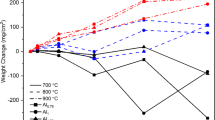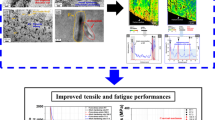Abstract
Severe plastic deformation (SPD) processes reduce drastically the grain size of metals, leading to a substantial increase of mechanical strength. Additionally, it has been observed that the precipitation kinetics in some Al alloys is accelerated after SPD, and thus suitable heat treatments can be used as a strategy for further hardening. In this work an Al–17 % Ag alloy was processed by equal-channel angular pressing (ECAP) and aged at 400 °C for different lengths of time with the purpose of observing and quantifying the kinetics of precipitation and competitive growth of the Al2Ag phase, as well as the precipitate fracturing and dissolution by ECAP. Microstructure observation of samples aged before ECAP deformation showed that precipitate bending rather than fracturing was the dominant event. The Al2Ag plates precipitation kinetics were studied on samples aged in the coarse-grained condition and after ECAP; results show that in the former group of samples the kinetics is well described by the Ham, Horvay and Cahn analysis. In the ECAP processed samples, a much faster than expected Ostwald ripening type of growth was observed. Such behaviour was attributed to a dislocation substructure stabilized by the Al2Ag precipitates.





Similar content being viewed by others
References
Langdon TG (2013) Twenty-five years of ultrafine-grained materials: Achieving exceptional properties through grain refinement. Acta Mater 61:7035–7059
Vedani M, Bassani P, Tuissi A, Angella G (2004) Ultrafine grained alloys produced by severe plastic deformation: issues on microstructural control and mechanical behaviour. Metall Sci Technol 22:21–30
Zheng LJ, Chen CQ, Zhou TT, Liu PY, Zeng MG (2003) Structure and properties of ultrafine-grained Al–Zn–Mg–Cu and Al–Cu–Mg–Mn alloys fabricated by ECA pressing combined with thermal treatment. Mater Charact 49:455–461
Chinh NQ, Gubicza J, Czeppe T, Lendvai J, Xu C, Valiev RZ, Langdon TG (2009) Developing a strategy for the processing of age-hardenable alloys by ECAP at room temperature. Mater Sci Eng A516:248–252
Zhao YH, Liao XZ, Jin Z, Valiev RZ, Zhu YT (2004) Microstructures and mechanical properties of ultrafine grained 7075 Al alloy processed by ECAP and their evolutions during annealing. Acta Mater 52:4589–4599
Radetic T, Popovic M, Romhanji E, Verlinder B (2010) The effect of ECAP and Cu addition on the aging response and grain substructure evolution in an Al–4.4 wt% Mg alloy. Mater Sci Eng A527:634–644
Prados EF, Sordi VL, Ferrante M (2013) The effect of Al2Cu precipitates on the microstructural evolution, tensile strength, ductility and work-hardening behaviour of a Al–4 wt% Cu alloy processed by equal-channel angular pressing. Acta Mater 61:115–125
Lee S, Utsunomiya A, Akamatsu H, Neishi K, Furukawa M, Horita Z, Langdon TG (2002) Influence of scandium and zirconium on grain stability and superplastic ductilities in ultrafine-grained Al–Mg alloys. Acta Mater 50:553–564
Ohashi K, Fujita T, Kaneko K, Horita Z, Langdon TG (2006) The aging characteristics of an Al–Ag alloy processed by equal-channel angular pressing. Mater Sci Eng A437:240–247
Kim JK, Jeong HG, Hong SI, Kim YS, Kim WK (2001) Effect of aging treatment on heavily deformed microstructure of a 6061 aluminum alloy after equal channel angular pressing. Scripta Mater 45:901–907
Murayama M, Horita Z, Hono K (2001) Microstructure of two-phase Al–1.7 at.% Cu alloy deformed by equal-channel angular pressing. Acta Mater 49:21–29
X-c Xu, Z-y Liu, Y-t Li, Dang P, S-m Zeng (2008) Evolution of precipitates of Al–Cu alloy during equal-channel angular pressing at room temperature. Trans Nonferrous Met Soc China 18:1047–1052
Chowdhury SG, Xu C, Langdon TG (2008) Texture evolution in an aluminum alloy processed by ECAP with concurrent precipitate fragmentation. Mater Sci Eng A473:219–225
Ferrante M, Doherty RD (1979) Influence of interfacial properties on the kinetics of precipitation and precipitate coarsening in aluminium-silver alloys. Acta Metall 27:1603–1614
Ham FS (1958) Theory of diffusion-limited precipitation. J Phys Chem Solids 6:335–351
Horvay G, Cahn JW (1961) Dendritic and spheroidal growth. Acta metall 9:695–705
Abbot K, Haworth CW (1973) Dissolution of γ phase in Al–Ag alloys. Acta Metall 21:951–960
Boyd JD, Nicholson RB (1971) The coarsening behaviour of θ″ and θ′ precipitates in two Al–Cu alloys. Acta Metall 19:1379–1391
Lifshitz IM, Slyozov VV (1961) The kinetics of precipitation from supersaturated solid solutions. J Chem Phys Solids 19:35–50
Wagner C (1961) Theorie der Alterung von Niederschlägen durch Umlösen (Ostwald-Reifung). Z Elektrochem 65:581–591
Adda Y, Philibert J (1966) La Diffusion dans les Solides. Presses Universitaires de France, Paris
Divinski SV, Reglitz G, Rosner H, Estrin Y, Wilde G (2011) Ultra-fast diffusion channels in pure Ni severely deformed by equal-channel angular pressing. Acta Mater 59:1974–1985
Fiebig J, Divinski S, Rosner H, Estrin Y, Wilde G (2011) Diffusion of Ag and Co in ultrafine-grained α-Ti deformed by equal channel angular pressing. J Appl Phys 110:083514–083518
Fujita T, Horita Z, Langdon TG (2004) Using grain boundary engineering to evaluate the diffusion characteristics in ultrafine-grained Al–Mg and Al–Zn alloys. Mater Sci Eng A 371:241
Stumpf WE, Sellars CM (1979) The mechanism of phase transformations in crystalline solids. The Institute of Metals, London
Divinsky SV, Reglitz G, Wegner M, Peterlechner M, Wilde G (2014) Effect of pinning by an orientation gradient on the thermal stability of ultrafine grained Ni produced by equal channel angular pressing. J Appl Phys 115:113503–113506
Raju KS, Sarma VS, Kauffmann A, Hegedűs Z, Gubicza J, Peterlechner M, Freudenberger J, Wilde G (2013) High strength and ductile ultrafine-grained Cu–Ag alloy through bimodal grain size, dislocation density and solute distribution. Acta Mater 61:228–239
Acknowledgements
The authors wish to thank the Foundation for Science Support of the São Paulo State (FAPESP) for financing this work.
Author information
Authors and Affiliations
Corresponding author
Appendix
Appendix
-
(i)
HHC analysis—parameter β
$$ \varOmega = \exp \left( \beta \right)\beta^{3/2} A^{2} \int\limits_{\mu = \beta }^{\mu = \infty } {\frac{{{ \exp }( - \mu )\partial \mu }}{{\left\{ {\beta \left( {A^{2} - 1} \right) + \left. \mu \right\}\mu^{1/2} } \right.}}} $$The parameters Ω, β and A were defined in the text. The integral of the mathematical parameter μ must be evaluated numerically. The equation was solved using MAPLE 8.0.
-
(ii)
Boyd and Nicholson equation:
$$ \bar{l}^{3} - \bar{l}_{0}^{3} = \frac{128}{9}\frac{{\gamma AC_{0} DV_{m}^{2} }}{\pi RT}(t - t_{0} ) $$\( \overline{l } \) and \( \bar{l}_{0} \) are, respectively, the precipitate average diameter after t and t 0 ageing time, γ the precipitate/matrix interface energy (0.5 J m−2), and V m the molar volume (1 × 10−5 m3 mol−1). R is the universal gas constant (8.4 J mol−1 K−1) and T is the ageing temperature (673 K). A, C 0 and D were defined in the text. For the calculation, \( \bar{l}_{0} \) and t 0 were equated to zero.
Rights and permissions
About this article
Cite this article
Sordi, V.L., Feliciano, C.A. & Ferrante, M. The influence of deformation by equal-channel angular pressing on the ageing response and precipitate fracturing: case of the Al–Ag alloy. J Mater Sci 50, 138–143 (2015). https://doi.org/10.1007/s10853-014-8573-9
Received:
Accepted:
Published:
Issue Date:
DOI: https://doi.org/10.1007/s10853-014-8573-9




